Recently I have been listening to a few companies and their issue. Yes Bank, Adani Power, Vedanta, Kotak Mahindra Bank, BPCL. These companies were in the news due to some reason. Directly or indirectly, it is related to their promoter. So A question came into mind whether promoters are a liability or a lighthouse?
Let us take an example of the Aditya Birla group. from Aditya Vikram Birla to Kumar Mangalam Birla. Both have their styles and ways of managing companies. Tata group can also be an example in many ways. The recent fight between Ratan Tata and Cyrus Mistry is a case study to learn about promoters and their issue and growth. Vijay Mallya. His father was one prominent businessman but failed to handle business after earlier success. Uday Kotak. Does one great business without a prominent business family. Yes, support from Mahindra was there, but it was not significant.
So my question is, Is promoter Liability or lighthouse?
Before writing this blog post, I searched for what companies have the lowest promoter holding. Many big names don’t have and promoter. HDFC, ICICI Bank, L&T, CARE Rating, and all the listed exchanges don’t have any promoter. Yes Bank has 1.1%, but they also declassified themselves as Non-promoters. Infosys has 13%. PVR 18.5%. UPL 27.89%. They are beyond doubt big players in their sector. So you may think that having low promoter holding is good. But while writing these, only 241 companies have promoters holding lower than 50% with a market capitalization of more than 500 crores. When it comes to promoter stakes more than 50% or more, there are 543 companies. If I make market capitalization at 1000 crore or more, the number will be 181 and 416, respectively. This makes it a little more interesting. I am unaware of the global scene, but I am sure the picture is more or less the same.
While doing the study for this blog post, I realized that we couldn’t ignore fiduciary duties. Fiduciary duties can be a good indicator for deciding whether the promoter is a liability or not. The champion is the one who combines capital, labor, and resources into going concerned. Without a doubt promoter or promoter group is the most significant stakeholder, but the moment he starts thinking that it is his private property, market forces will affect them.
I decided to write on this subject because I saw both sides—Anil Ambani, where strong profile business failed. After losing the tag as a promoter from Nippon India asset management, the share price starts performing. Modiluft or today’s Spicejet. Another example. Where the old champion enters and starts working.
Another aspect of this issue is that institutions are always better promoters than one man or one family. Of course, this case has some exceptions, but it is general. More the institutional holing better, it is.
So what is the secret of this issue? One simple thing I can say is that a company is going concerned. It is not one private property of someone person. There are many stakeholders. The moment promoter forgets it. No matter who he is, an institution or person’s downfall has already started.




